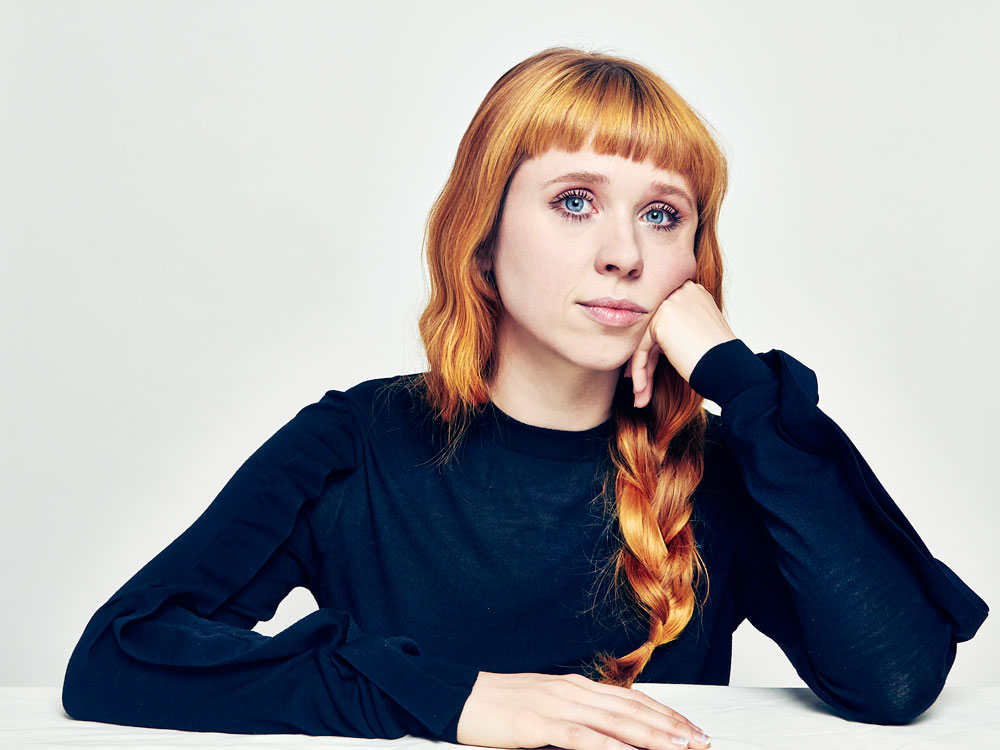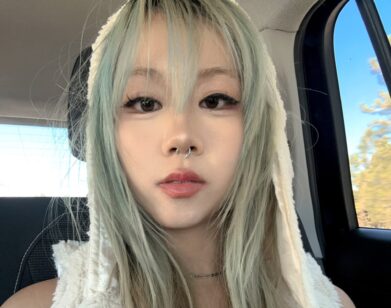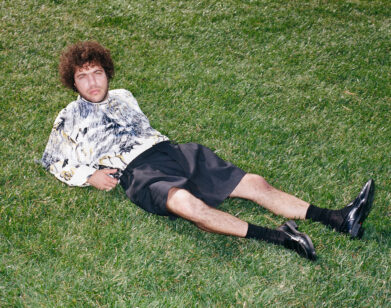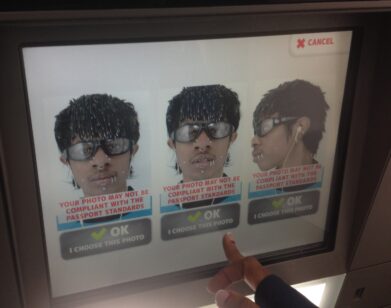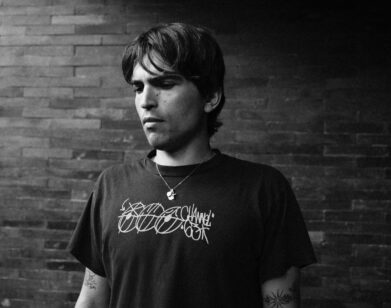Refracting Sound
HOLLY HERNDON IN NEW YORK, APRIL 2015. PHOTOS BY HAO ZENG. STYLING BY JULIA GALL. HAIR: ELOISE CHEUNG AT WALTER SCHUPFER MANAGEMENT USING RENE FURTERER. MAKEUP: CEDRIC JOLIVET AT SEE MANAGEMENT USING GIORGIO ARMANI BEAUTY.
Although she began in 2011 with a deep, solitary exploration of the laptop as an instrument, composer, musician, and sound artist Holly Herndon has since progressed toward a more cohesive sound. On her album Platform, which is out today via RVNG Intl and 4AD, Herndon brought in collaborators and merged genres. Herndon and her fellow artists created complex sonic landscapes and accompanying visuals, often referencing theory and popular culture alike.
The San Francisco-based artist first became interested in and absorbed by the dance and techno scene in Berlin, where she lived as a teenager after leaving her hometown of Johnson City, Tennessee. Upon returning to the States, she studied electronic music and received her MFA from Mills College in Oakland, California. Now, in addition to recording and developing her practice, Herndon is also a doctoral candidate in composition at Stanford’s Center for Computer Research in Music and Acoustics, and her live performances have taken her everywhere from Brussels to Barcelona, Lisbon to London, Berlin to Brooklyn, and from small venues like New York’s Boiler Room to the Solomon R. Guggenheim Museum.
On Platform, tracks such as “Chorus” allow Herndon’s voice to echo and reverb without taking any breaths for minutes at a time—a feat accomplished through her use of Max/MSP, a visual programming language. Herndon frequently uses the language to create custom instruments and vocal processes on her laptop. The resulting music is never hard to digest; each listen reveals new layers and innuendos, and the visuals always follow suit. Prior to the album’s release, we sat down with the artist in New York to speak about everything from her evolving practice to Donna Haraway’s “A Cyborg Manifesto.”
EMILY MCDERMOTT: For you, what was biggest change between Movement, your last album, and Platform? It’s been three years.
HOLLY HERNDON: I think the biggest aesthetic and conceptual change is that I opened up my practice. Movement was very much about this intimate exploration of the laptop, just me and the laptop in a room alone. While that was a really worthwhile exploration, with Platform, it felt like what we need right now, culturally and musically, is to look around us, to respond to what’s going on, and build relationships. That needs to start at home, in my own practice first, working with collaborators. A lot of the collaborators that I worked with, while they have art practices, are also heavily involved with other things. That’s also a way for me to expand my practice and bring in other influences and topics.
MCDERMOTT: What was it like working with other people?
HERNDON: It was really refreshing. It can get really lonely in the studio. Of course, there was still tons of alone studio time— there’s no way to get around that, especially if you’re doing electronic music, but a lot of tracks I did with my partner Mat Dryhurst. It was really nice to have that extra pair of ears. I think I’ll continue to collaborate. It’s a great way to get you out of your habits and ruts and the way you approach music. Also, some of the collaborators I worked with, I worked with online. Colin Self did “Unequal.” We did that over the internet and it took four days.
MCDERMOTT: So have you met in person?
HERNDON: Yeah, we met in person too. Each collaboration was different. With Spencer [Longo], we met in L.A. in the winter and started the ideation process. Then the text happened via email and Skype. Amnesia Scanner is based in Berlin, so I went to their studio for a couple days and worked there. I was traveling and touring and recording. I would record some tracks in London, then mix them in Berlin. It’s very reflective of our times. It’s all part of being mobile.
MCDERMOTT: And you’re still studying at Stanford for your PhD. What is it like balancing your studies with the recording process?
HERNDON: It’s been a crazy exercise in calendaring. [laughs] I’m writing while I’m at school, but usually take my long breaks as concentrated writing time. I had all of December off, so I went to a warehouse in L.A. and just wrote. Fortunately, my teaching commitments and my coursework commitments are over, so now I don’t have to be in the classroom anymore. I am looking forward to doing a studio album that’s in one place.
MCDERMOTT: “Locker Leak” was one of my favorite tracks. The lyrics are pretty funny. With the line, “Be the first of your friends to like Greek yogurt in the summer,” there’s this idea of pure nonsense.
HERNDON: I made that piece with Spencer Longo, a visual artist who has an amazing sense of aesthetics. He’s great at taking different pieces—recognizable and non-recognizable—from pop culture or from daily life and rearranging them in new ways. He does that with language as well, so he wrote the text that I then placed to music.
The reason we started working together was that he has this Twitter handle called “Chinese WiFi.” It’s basically these little word sculptures—his idea was like, “In today’s economy, you don’t actually need to actually create the sculpture. You can just kind of create the word sculpture and then people can imagine it and that’s enough. You don’t need to put it in a gallery space.” So his whole Twitter was full of these little world sculptures, and it’s a very similar style to “Locker Leak.” It’s these little combinations, you can totally imagine what that person is trying to get across, and it’s vibrant and colorful. I used to be a huge fan of his Twitter, so I was like, “I really want you to write the lyrics for one of my tracks.”
MCDERMOTT: I know you’ve been interested in and influenced by “A Cyborg Manifesto.” How do you feel about body modification and artists like Stelarc?
HERNDON: In terms of Donna Haraway’s “A Cyborg Manifesto,” I see that less as Stelarc body modification, and more as using the cyborg as a metaphor to imagine a different future. She uses it to reimagine what it could mean to be a woman in the future. I don’t think that has to involve modification. I think it can just mean how we perceive each other, how we treat each other as members of society. I think Stelarc is a super interesting artist, but I’m not grafting an ear to my arm anytime soon. [laughs]
I think one of the interesting things about digital music, especially a lot of the vocal processing that I do, is almost like an oral version of that—I can take my voice and free it from its physical confinements and get it to do anything. I can expand my range, I can sing for five minutes without taking a breath, because I can modify my voice digitally. I find that really empowering. Also, the majority of female voices that we hear on the airwaves today have been produced by males—they go through that filter of what an idealized voice should sound like—so I think it’s empowering to make that whatever I want it to be, whether that be beautiful or ugly or harsh. For it to go through my own filter is really empowering. I think that gives us the opportunity, like Haraway uses the metaphor for the cyborg, to reimagine what music can sound like and frees us from the tropes and archetypes of the past. We can design a new fantasy, like what is our new fantasy that reacts to contemporary conditions?
MCDERMOTT: What is yours?
HERNDON: I think right now I’m fantasizing about collective action. I’m definitely an optimist, not one of those Bay Area solutionist optimists, but that’s my fantasy right now: people working together to try to find alternate scenarios to our current scenario, because what we’re doing right now isn’t working.
MCDERMOTT: In terms of?
HERNDON: In terms of capitalism.
MCDERMOTT: Do you think a lot about the way other cultures are working when making music?
HERNDON: I don’t really take an anthropology or musicology approach, but the different people that I work with bring their own cultural perspective, so I think that plays into it. I’ve been working with a Japanese artist for a couple years, Akihiko Taniguchi, this media artist [who is] super technically proficient and also has this amazing aesthetic. It’s fun to work with him because he doesn’t speak English and I don’t speak Japanese, so we Skype and don’t talk. We just smile at each other, and then we type and use Google translate. We’ll just exchange a few words, then exchange files, and it’s perfect. Sometimes you just find someone and it’s just so easy…
MCDERMOTT: Music literally becomes the universal language.
HERNDON: And with his visual art, it’s this perfect combination.
MCDERMOTT: How do you think the presence of the laptop and technology has changed since your last release in 2012?
HERNDON: When I was writing Movement I was on this crusade, like “Laptops are instruments too!” Now I feel like people have accepted it and that doesn’t have to be a discussion anymore, but that doesn’t necessarily solve the performance issues. I still think that laptop performance can be alienating or dull for some people. I think that’s ongoing research that needs to be done, so I’m interested in continuing that.
MCDERMOTT: So if it the discussion was advocating laptops as instruments, what is it now?
HERNDON: For this album, it’s about opening up my practice and finding ways to magnify the people whose work I really respect—the collaborators as well as the people I’m referencing, like Suhail Malik. He’s a theorist who writes a lot about contemporary artwork right now and how we need to design an exit strategy from current conditions instead of an escape mechanism.
That’s something I’ve been thinking about in the last couple years, especially with dark techno and experimental music being in the club. That’s all been wonderful, but a lot of it felt like it was still this insular, looking inward approach to music and culture. I think what we need is to be looking outside of ourselves, creating partnerships with people, creating communities, creating the environment that we want. Instead of being depressed at the current situation, coming together and making it…
MCDERMOTT: Proactive.
HERNDON: Exactly. If I could distill it into one word I would say proactivity, and that’s an ongoing thing. It’s not like, “Oh, I made an album. Check!” I need to see this through, integrate it into my live performances, and continue the process.
MCDERMOTT: Do you ever bring your collaborators into the live performances?
HERNDON: I will be! There are several shows planned with collaborators and some theorists that I’m reading. I’m trying to expand the live set to include some of these things in a way that’s not didactic or dogmatic in any way.
One thing that music is really amazing at is getting people in a room together to feel emotion together. I want to be able to harness that energy and that activity to talk about things other than music. If you look at all the people at your concert, you have a room full of fascinating, smart, clued-in people. They should be communicating with each other. We should harness that heat.
MCDERMOTT: As both a very creative person, but also very academic and interested in theory, do you ever try to separate those two world or are they one in the same?
HERNDON: I definitely separated it for a long time and it drove me crazy. It wasn’t anyone wanting me to separate it; it was just my own brain trying to separate it. Even my professors were like, “Why are you separating this?” It’s totally fine for me to play a pop song in a critique, next to another student who might be doing an acoustic ensemble new complexity piece or a bassoon solo. I think it’s very apparent on Movement that I was still breaking things up, because it’s like, “This is an experimental track. This is not an experimental track.” With Platform they’re married in a more holistic way. That’s what I’m working toward. Some of the tracks are always just going to be experimental—like “Lonely at the Top” is obviously not a pop track—but I would like to be able to fuse both the most abstract and the most accessible things together.
Music is about communication, [not] about putting up a wall and being like, “I’m so weird. You’ll never understand me.” It can all be fused together. Everybody’s playlist is jumbled together. Everybody experiences music in a jumbled way. It’s almost schizophrenic, but that’s the new coherence. I think music should reflect that.
PLATFORM IS OUT TODAY VIA RVNG INTL AND 4AD. FOR MORE ON THE ARTIST, VISIT HER WEBSITE.

